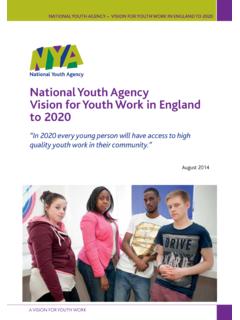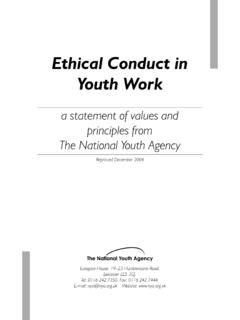Transcription of The NYA Guide to Youth Work in England
1 1 The NYA Guide to Youth work in England the Government s view [is] that high quality Youth work , delivered by third and statutory sectors, is central to delivering our ambition of increasing the number of young people on the path to success and an important function of integrated Youth support services. Aiming high for young people, HM Treasury/DCSF 2007. Youth work in brief Youth work helps young people learn about themselves, others and society through activities that combine enjoyment, challenge, learning and achievement. It is a developmental process that starts in places and at times when young people themselves are ready to engage, learn and make use of it. The relationship between Youth worker and young person is central to this process. Youth work happens in Youth centres, schools and colleges, parks, streets and shopping precincts wherever young people gather. Youth work methods include support for individuals, work with small groups and learning through experience.
2 Youth work offers young people safe spaces to explore their identity, experience decision-making, increase their confidence, develop inter-personal skills and think through the consequences of their actions. This leads to better informed choices, changes in activity and improved outcomes for young people. Youth work contributes to the government s vision for young people that they should enjoy happy, healthy and safe teenage years that prepare them well for adult life and enable them to reach their full potential. From January 2007, local authorities have been required to secure positive activities , including Youth work , for young people in their area. These activities should be shaped by what young people say they want, and should help put them on the path to success . So what is Youth work ? Youth work helps young people learn about themselves, others and society, through informal educational activities which combine enjoyment, challenge and learning.
3 Youth workers work primarily with young people aged between 13 and 19, but may in some cases extend this to younger age groups and those aged up to 24. Their work seeks to promote young people s personal and social development and enable them to have a voice, influence and place in their communities and society as a whole. Youth work is underpinned by a clear set of values. These include young people choosing to take part; starting with young people s view of the world; treating young people with respect; seeking to develop young people s skills and attitudes rather than remedy problem behaviours ; helping young people develop stronger relationships and collective identities; respecting and valuing differences; and promoting the voice of young people. This is considered in more detail in the National Youth Agency statement of principals and values, Ethical Conduct in Youth work . 2 Youth work has its origins in the clubs and projects set up by voluntary organisations often with a religious intent - in the 19th century.
4 Many of these, such as the Boys Brigade and the Young Women s Christian Association, still exist today as national voluntary Youth organisations. State recognition for Youth work dates from the outbreak of war in 1939. Since then, Youth services have developed as a complex network of providers including community groups, voluntary organisations and local authorities. Services which provide Youth work are currently changing, as a result of the government s focus on delivering joined up provision for children and young people. Local authorities, of which there are 150 in England , are responsible for securing Youth work in their areas, and Youth services now normally form part of their children and young people s services. Each of these local authorities is required to develop a plan which covers all provision for children and young people and shows how it meets government priorities. By April 2008, they are expected to secure provision through integrated Youth support and development services delivered through children s trusts (which bring together local authority children s services with a range of other partners).
5 Youth work will form an important part of these integrated services, which have three main elements: universal services for all young people; targeted support for young people who need it most; and information, advice, guidance and counselling. Funding for services to young people comes mainly from central and local government. While the government sets notional levels of expenditure, local authorities have the scope to vary these, either up or down. The level of funding therefore varies widely between authorities, as The NYA has highlighted in its series of annual Youth service audits . Its audit for 2005-06 found that local authorities spent a total of 452 million on Youth services. The 2005-06 audit also found that local authority Youth services in England employed over 4,000 professional Youth workers and over 17,000 Youth support workers (see Becoming Qualified for information on different Youth work roles).
6 Nearly 900 people were employed in managerial positions. Voluntary Youth organisations also employ a significant number of Youth work staff, as do faith organisations. While there are no absolute figures for the number of volunteer Youth workers, it is estimated that there may be over 500,000 volunteers, mainly in the voluntary, community and faith sectors. The quality of children s services and Youth services are currently monitored and evaluated by a body known as Ofsted the Office for Standards in Education, Children's Services and Skills. By December 2008, Ofsted will have carried out joint area reviews - which judge the contribution that a council and its partners are making to improving outcomes for children and young people - in all 150 local authorities in England . These reviews include enhanced coverage of Youth work in authorities where Youth services have not been inspected since 2005.
7 The policy context The government s Every Child Matters: Change for Children programme seeks to provide a new approach to the well-being of children and young people from birth to 3 19. It aims for every child and young person, whatever their background or circumstances, to have the support they need to: Be healthy; Stay safe; Enjoy and achieve; Make a positive contribution; and Achieve economic well-being These five ECM outcomes underpin all aspects of government policy relating to children and young people. Policy specifically relating to young people was set out in Youth Matters (2005), and Youth Matters: next steps (2006), which developed proposals for a radical reshaping of universal services for teenagers with targeted support for those who need it most . Since January 2007 there has been a statutory duty on local authorities, working in partnership with the voluntary and private sectors, to promote the well-being of young people aged 13 to 19 (up to 25 for those with learning difficulties) through securing access to educational and recreational leisure-time activities (referred to as positive activities ).
8 This duty was set out in Clause Six of the Education and Inspections Act 2006, which gives effect to the proposals contained in Youth Matters. Youth Matters stated that the government would provide statutory guidance for local authorities setting out a new set of national standards for positive activities. This would include: Access to two hours per week of sporting activity including formal and informal team sports and other activities such as outdoor adventure, aerobics and dance. Two hours per week of constructive activities in clubs, Youth groups and classes. These might include young people s own hobbies and interests; personal, social and spiritual development activities; study support; activities encouraging creativity, innovation and enterprise; and residential opportunities. Opportunities to make a positive contribution through volunteering, including taking a lead on campaigning and fundraising.
9 A wide range of other recreational, cultural and sporting and enriching experiences. Safe and enjoyable places to spend time, including socialising with friends. This combination of opportunities is often referred to as the local Youth offer . In July 2007, the government published Aiming high for young people, which sets out a ten-year strategy for positive activities. It proposes a range of initiatives under three main headings: Empowerment: giving young people and communities real influence; Access: attracting and engaging every young person; and Quality: effective services delivered by a skilled workforce. 4 The strategy has a particular stress on improving local Youth facilities, increasing young people s influence over activities and provision (including direct control of some budgets) and developing the Youth workforce. The Children s Plan, which set out the government s vision for children, young people and families based on putting their needs at the centre of integrated services, was published in December 2007.
10 This identified three areas in which it wanted to strengthen the commitments made in Aiming high for young people: setting a clear goal that all young people will participate in positive activities and access a broad range of experiences; making further investment to improve places to go in every community; and exploring ways of improving information about things to do and places to go. How is Youth work carried out? Youth work is carried out in different situations and locations, using a range of approaches. However, some common factors underpin good Youth work , whatever the setting. HM Treasury s policy review on children and young people highlights seven factors which need to be in place to improve outcomes for young people. These are: Providing opportunities to build the skills of young people; Developing young people s personal effectiveness through building their ability to arrive at their own choices and solutions to problems; Making links between the different aspects of young people s lives; Setting and demonstrating appropriate standards of behaviour; Keeping young people safe from physical and mental harm; Putting proper supervision in place, through which adults provide clear, appropriate and consistent rules and expectations; and Sustaining young people s involvement over time.






